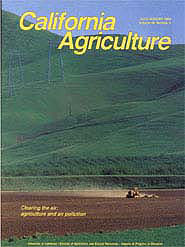All Issues

Clearing the air: agriculture and air pollution
Cover:
As California tries to improve its air quality, UC researchers are helping the agricultural industry find out which farming practices kick up the most dust and how they can be changed to clear the air. Photo by Jack Kelly Clark
July-August 1994
Volume 48, Number 4
Volume 48, Number 4





